Barley and Pomegranate Salad
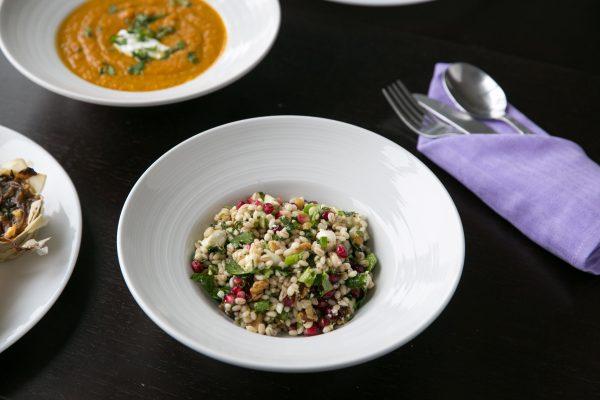
This recipe was inspired by a dish eaten in ancient times made with crushed wheat, cheese, honey, pomegranate, and nuts. Before serving, I often spoon the salad into molds and turn them onto serving plates. You can eat this on its own or as a side dish.
Serves 4
- 1 1/4 cups pearl barley
- 7 ounces Greek feta
- 1/2 cup pomegranate seeds, plus extra to garnish
- 1/2 cup (2 ounces) walnuts, toasted and roughly chopped
- 3 tablespoons finely chopped mint, plus extra leaves to garnish
- 2 tablespoons finely chopped flatleaf parsley, plus extra leaves to garnish
- 3 tablespoons finely chopped scallion
For the Dressing
- 2 teaspoons ground cumin
- 1/4 cup olive oil
- 2 tablespoons red wine vinegar
- 1 tablespoon honey
- 1 to 2 cloves garlic, minced
- Sea salt and cracked pepper
Bring 3 cups of salted water to a boil, then reduce to a simmer. Rinse the pearl barley and add to the pan. Cook for 20 to 25 minutes, or until the barley has softened.
Drain, then place in a bowl and cool to room temperature. Cut the feta into cubes and add to the barley with the remaining salad ingredients. Mix together well. Combine the dressing ingredients in a small bowl and pour over the barley salad.
Toss gently. Sprinkle the extra mint and parsley leaves as well as pomegranate seeds on the salad.
Recipe reprinted with permission from “My Greek Family Table” by Maria Benardis. Published by Countryman Press.Hippocrates’s Carrot Soup
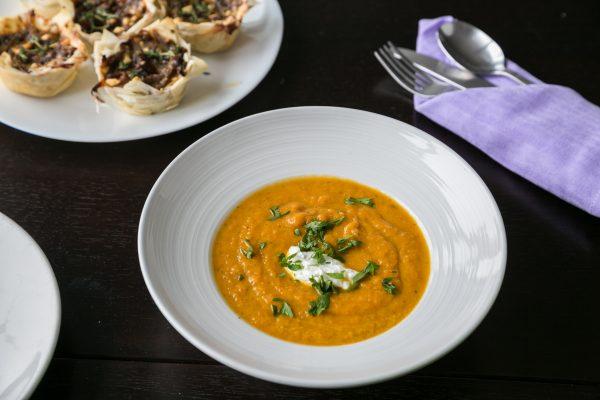
This is my interpretation of Hippocrates’s healing carrot soup. After consuming a bowl of this soup, you will feel cleansed and healed. It warms the body and settles the tummy. It’s a great alternative to the soulful chicken soup.
Serves 6
- 4 tablespoons extra-virgin olive oil
- 2 leeks, white part only, thinly sliced
- 2 pounds carrots, peeled and chopped
- 3 stalks celery, thinly chopped
- 4 cups vegetable or chicken stock
- 1 cup flat-leaf (Italian) parsley, plus 2 tablespoons extra, to garnish
- 2 teaspoons chopped thyme leaves
- 1 to 2 teaspoons ground cumin
- Sea salt and cracked black pepper, to taste
- 6 tablespoons plain Greek-style yogurt, to garnish
Heat the olive oil in a large saucepan over medium heat. Add the leek, carrot, and celery and cook uncovered, stirring occasionally, for 5 to 8 minutes or until the vegetables start to soften. Add the stock, parsley, thyme, cumin, salt, and pepper and mix well. Cover and bring to a low simmer and cook for 20 to 25 minutes or until the carrots are very tender.
Remove from the heat and set aside to cool slightly. Place the cooked vegetables into a food processor or blender and process until smooth. Return the soup to the saucepan and heat over medium-high until hot. Ladle the soup into serving bowls and season with a tablespoon of yogurt and the extra parsley.
Serve while still hot.
Recipe reprinted with permission from “Cooking & Eating Wisdom for Better Health: Ancient Greek Wisdoms for Cooking, Eating and Living Better,” published by Balboa Press, and “My Greek Family Table,” published by Countryman Press, by Maria Benardis.
Mykonean Caramelized Onion Filo Parcels
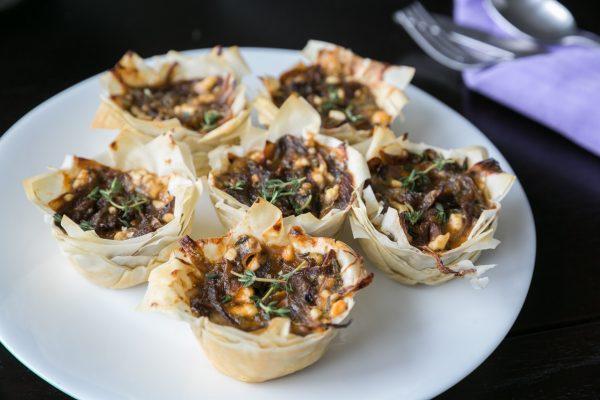
In Mykonos, they use onion in their pies. I have come up with my own interpretation, where they look like gorgeous flowers when they come out of the oven.
Makes 12
- 2 tablespoons extra-virgin olive oil, plus extra for brushing
- 8 red onions, finely chopped
- 2 teaspoons finely chopped rosemary
- 2 teaspoons finely chopped thyme
- Sea salt and cracked pepper
- 1 tablespoon (preferably thyme-infused) honey
- 7 to 8 ounces grated Greek feta
- 2 eggs, lightly beaten
- 12 sheets filo pastry
When the mixture has cooled, drain off any liquid and add the feta and beaten egg. Mix well.
Cut the filo pastry into four long strips, then cut each strip into 2- by 2-inch squares. Place the filo squares between two clean tea towels so they do not dry out. Preheat the oven to 350 degrees F and brush 12 muffin cups with extra virgin olive oil. Line the muffin cups with filo, brushing every second piece with olive oil. Continue until the base and sides are well covered (you will need about 12 pieces for each). Spoon the caramelized onion mixture into the cups and season with salt and pepper.
Bake for 30 to 35 minutes, then serve while still hot.
Recipe reprinted with permission from “My Greek Family Table” by Maria Benardis. Published by Countryman Press.
Aegina-Style Salmon With Pistachio Crust
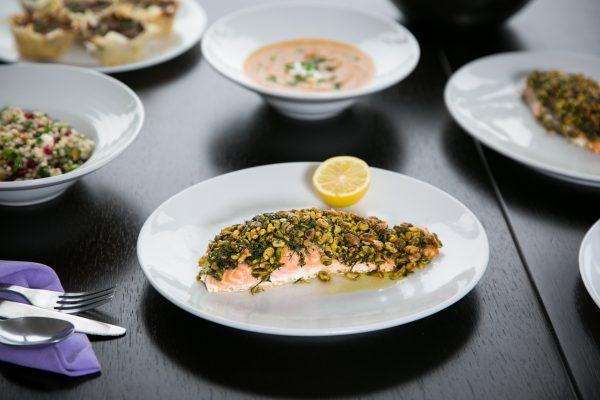
Located in the Saronic Gulf, the island of Aegina not only has an abundance of fresh seafood but is also where the best pistachios in Greece are grown.
Serves 4
- Four 7- to 8-ounce fresh salmon fillets, skin on, bones removed
- Sea salt and cracked pepper
- 1/2 cup extra-virgin olive oil
- 1 cup unsalted raw shelled pistachios
- 2 tablespoons grated lemon zest
- 4 tablespoons chopped dill
Place the salmon pieces on the tray and season with salt, pepper, and about 1 tablespoon of the olive oil.
Place the pistachios in a mortar and grind with the pestle until they are coarsely broken up. Add the lemon zest, dill, pepper, salt, and the remaining olive oil, mix well, and grind a little more. Spoon the mixture onto the salmon pieces and spread so it forms an even crust. Bake for 20 to 25 minutes, or until the fish is cooked.
Serve with zesty pomegranate and pastourma salad.
Recipe reprinted with permission from “My Greek Family Table” by Maria Benardis. Published by Countryman Press.

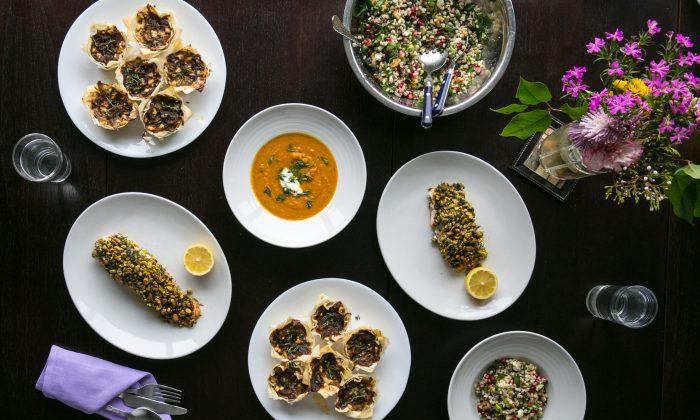




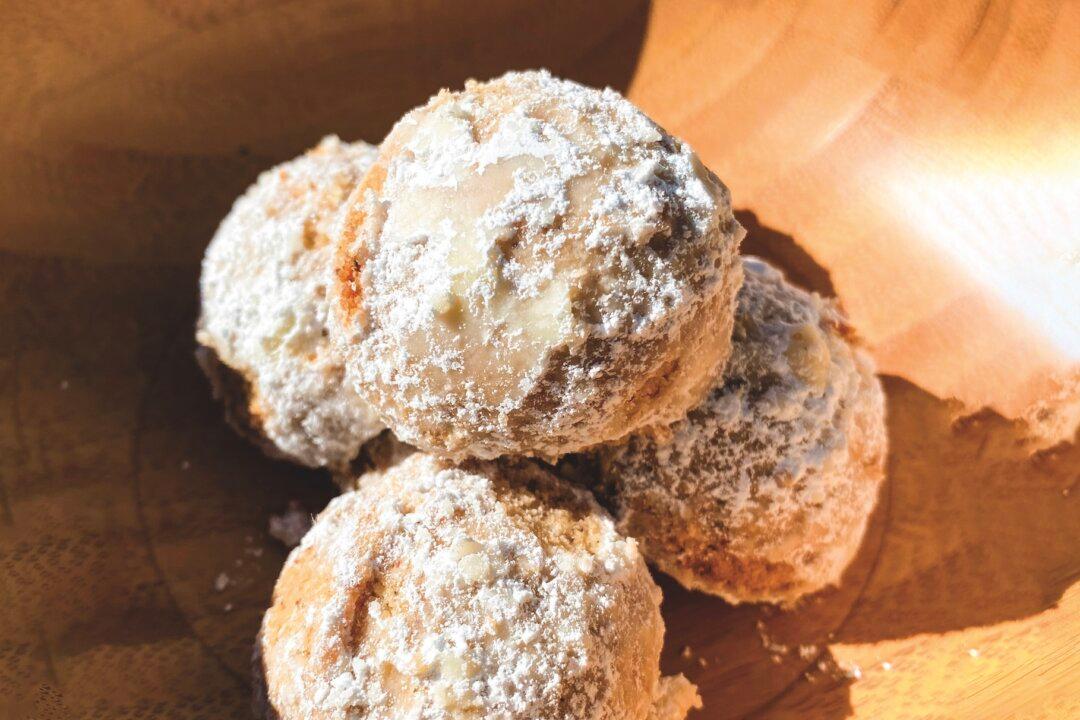
Friends Read Free